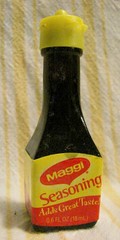 I have a secret ingredient that I use in my soups, stews, gravies, and sauces: Maggi Seasoning, grey-market-imported from Switzerland. This particular Swiss version of Maggi contains an ingredient no other Maggi Seasoning has: extract of lovage (an herb related to celery.) As awesome as slowly-simmered homemade soup is, Swiss Maggi makes it even more awesome.
I have a secret ingredient that I use in my soups, stews, gravies, and sauces: Maggi Seasoning, grey-market-imported from Switzerland. This particular Swiss version of Maggi contains an ingredient no other Maggi Seasoning has: extract of lovage (an herb related to celery.) As awesome as slowly-simmered homemade soup is, Swiss Maggi makes it even more awesome.Maggi is made by the Nestle Company, and they tailor many of their products to appeal to mysteriously-defined arbitrary demographics. Right now, in my kitchen, I have four bottles of Maggi Seasoning. Each of them is from a different country, and every single one of them tastes different from the others. The bottle at right is a 500ml bottle of Swiss Maggi. The lovage extract in it makes the flavor rich, deep, and more complex than many of the other Maggis in my cupboard. A few shakes of it in a pot of chicken soup awakens a dimension of flavor which is otherwise unavailable.
 This is the Maggi I find most commonly in American supermarkets and Asian markets here in the US. It tastes a lot like soy sauce, although there's no soy in it - just wheat gluten, wheat bran, yeast extract, and MSG. It's lighter in color than the other Maggi sauces. I don't like it as much as I do the euro versions, though it has it's place. Because it has a lighter taste than most standard soy sauces, I use it to season stir-fries and fried rice.
This is the Maggi I find most commonly in American supermarkets and Asian markets here in the US. It tastes a lot like soy sauce, although there's no soy in it - just wheat gluten, wheat bran, yeast extract, and MSG. It's lighter in color than the other Maggi sauces. I don't like it as much as I do the euro versions, though it has it's place. Because it has a lighter taste than most standard soy sauces, I use it to season stir-fries and fried rice. Some friends traveling to Germany brought back a couple bottles of the German Maggi version for me, thinking it would be the same as the Swiss product I'd been using. The flavor was close - very close - to the Swiss, but not the same (saltier for one thing) and there isn't any lovage extract on the ingredient list. It's my second favorite Maggi.
Some friends traveling to Germany brought back a couple bottles of the German Maggi version for me, thinking it would be the same as the Swiss product I'd been using. The flavor was close - very close - to the Swiss, but not the same (saltier for one thing) and there isn't any lovage extract on the ingredient list. It's my second favorite Maggi. This version is made in Poland. The ingredient list on the label shows salt, MSG, glucose, yeast extract, and artificial flavorings. The flavor of this variety is less soy-like than the American product, more hearty and "browner," kind of like a half-way compromise between the saltier German variety and the lovage-flavored Swiss product. It's particularly good in beef and pork gravies and as a seasoning in onion soup.
This version is made in Poland. The ingredient list on the label shows salt, MSG, glucose, yeast extract, and artificial flavorings. The flavor of this variety is less soy-like than the American product, more hearty and "browner," kind of like a half-way compromise between the saltier German variety and the lovage-flavored Swiss product. It's particularly good in beef and pork gravies and as a seasoning in onion soup.Links:
My Love For Maggi Seasoning Sauce - a blog post on Eat Drink & Be Merry featuring an extensive selection of Maggi sauces from different areas.
The Swiss Food Store - Here you can buy the original Maggi, the one with the lovage extract, and you can enjoy using the same secret ingredient I do. They also have a wide selection of other Swiss foods.
Links to other Dave's Cupboard posts in the Seasonings category:
Part One: Seasoned Salts
Part Two: Bacon Salt Without the Hype
.

2 comments:
I used to bring something similar back from my trips to England. Don't think that it was the actual Maggi brand. Wish I could remember the name of the stuff. Back in Cleveland, Heinen's grocery store used to carry it. I had no idea what the ingredients were, but my stews and soups haven't tasted the same without it. Thanks to your post I'm going on a hunt for the little brown bottle. :)
Re: Swiss Maggi
Lovage is a tough perennial. If "Dutch Farmer Bill" can grow it in the ottawa Valley, you can grow it in Conn.
YK Jim
Post a Comment